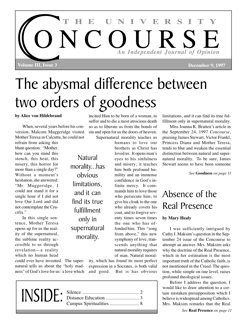Campus Spiritualities: Responding to charismatic critics
by Adam Tate
Though with great reluctance, I jump back into the fray of the charismatic/traditionalist debate. First I wish to concede one point to my critics. My article implied that the charismatic gifts are human creations or a man-made spirituality. I did not intend to say that, but in rereading my article I can see why people attacked me on that point.
I still maintain that the exercise of the charisms during the Mass is inappropriate. There are a few points I wish to make concerning the claims that the charismatic gifts comprise the spirituality of the Church and the uses of the charismatic gifts in the liturgy.
The fact of the matter is that God does not choose to give everyone the charismatic gifts. Alicia Hernon and James Weiner argue that “all can use charismatic gifts” (Weiner) and that the “gifts are for every Catholic.” (Hernon) If history bore out their claims, I would have to concede defeat. But instead history reveals that after a brief flourishing in the early Church, the charismatic gifts virtually disappeared. It is because of this disappearance that the modern charismatic revival can call itself a renewal. For a renewal means a recapturing of something that has been lost or has declined. The logic of the arguments of Hernon and Weiner leads to the preposterous conclusion that one cannot have the fullness of the Holy Spirit, and thus be fully Catholic, without practicing the charismatic gifts (a position not taught by the Church). Many of the greatest saints of the Church did not practice the charisms. Yet should one believe that these holy men and women did not have the fullness of the Holy Spirit because they lacked the charismatic gifts? Of course not. Because they are not given to all, it follows that the charisms should be treated as a private spirituality in the context of Catholic liturgical practice.
Liturgy is the common action of the People of God and thus must reflect the universality of the Church through ritualized, public action.
The Catechism notes, “Liturgy is a constitutive element of the holy and living Tradition.” (1124) “For this reason, no sacramental rite may be modified or manipulated at the will of the minister or the community.” (1125) By claiming the charisms are the tradition of the Church and thus deserve a place in the liturgy, charismatics place themselves above the Magisterium, which has not included the charisms in the Mass. The exercise of the charisms during Holy Mass, even when well intentioned, is inappropriate and distorts the Catholic meaning of liturgy.
Both Hernon and Weiner use Fanning the Flame as their authoritative guide to the history of the charisms. Fanning the Flame is a scholarly work of theology derived from a larger more extensive work on the charisms in the early Church by Kilian McDonnell and George Montague. As a work of scholarship, it depends on the evidence it uses to prove its thesis. The authors assert that the practice and experience of the charisms within the liturgy of initiation was normative until the eighth century. McDonnell and Montague imply that because the charisms were normal for seven centuries, they comprise the normal and traditional life of the Church and can and should be practiced by everyone. The evidence used is quite shabby in places, making the thesis hard to accept. One example will suffice. The authors use statements of St. John Chrysostom (c. 347-407) to prove that the charisms were present in the early Church.(page 18) Chrysostom said of the early Church, “whoever was baptized at once spoke in tongues, and not only in tongues, but many prophesied; some performed many other wonderful works.” But the authors, for some inexplicable reason, continued quoting Chrysostom’s statement, which turned into a complaint about the fourth century Church. Chrysostom said that “the charisms are long gone” and that “the present Church is like a woman who has fallen from her former prosperous days.” “In many respects,” he added, “she retains only the tokens of that ancient prosperity.” (page 18) Chrysostom’s quotation thoroughly destroys the authors’ contention that the charisms were normative in the Church until the eighth century. If Chrysostom said in the fourth century that the charisms were “long gone,” is the reader supposed to believe they were normal in the eighth century? To believe such would deny the evidence used by McDonnell and Montague. It seems that the only logical conclusion one can draw from Fanning the Flame is that God, for some reason, stopped giving the charisms to everyone. Thus while the charismatic gifts may have been normal and common at first, they soon passed into the extraordinary.
The Church, recognizing the ritualistic and universal nature of liturgy, states in Sacrosanctam Concilium #22 that no one may “add, remove, or change anything in the liturgy on his own authority.” Hernon, Weiner, and Kathleen Van Schaijik disregard Sacrosanctam Concilium #22. Because the Church has not included the exercise of the charisms in the context of the Mass, it seems to me to be illicit, on the grounds of SC #22, to exercise them during the mass. Hernon implies that Sacrosanctam Concilium #22 does not respect diversity.1 Later she refers to the document’s preference for the organ in Catholic worship as unrealistic. Van Schaijik, with Weiner concurring, insists that to ban the charisms from the liturgy “could amount to a rejection of a divine gift, and a betrayal of the specific mission of our University.” But how can obedience to the Church’s directives on the liturgy be construed as rejecting God’s gifts? The charismatic renewal should not be banned from campus. Rather the charisms can serve the University by building up voluntary communities such as households.
Indeed, in their relativization of what belongs and does not belong in the liturgy, my critics resemble the Catholic liberals who wreak such havoc on the Mass. Therefore, my first article, which charged that an overemphasis on the charismatic renewal on campus has hindered the true liturgical reform called for by Sacrosanctam Concilium, has been vindicated. My three critics, who all identify themselves with the charismatic revival, seem to flout the directives of Sacrosanctam Concilium in order to include the charisms in the Mass. Thus it remains my conclusion that liturgical reform on campus will be hindered as long as charismatics insist on including the charisms in the liturgy.
Adam Tate graduated in 1994.
- Many Catholics misunderstand the Church’s respect for liturgical diversity. Unlike the liberals who want to privatize all public, ritualistic expressions of the faith, the Church believes that her liturgical diversity is expressed through her many different rites of worship. ↑


